 HOME: www.hiltonpond.org |
|||
|
RUFOUS HUMMINGBIRD |
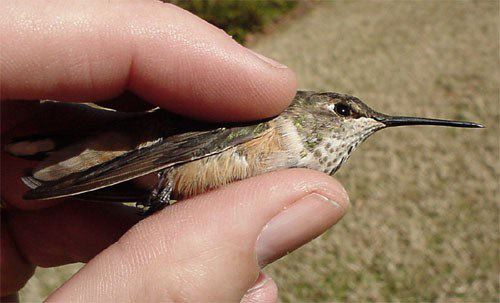 After a flurry of vagrant hummingbird bandings at the end of 2002, the new year got off to a slow start. We finally got word of winter hummers at two widely separated locations in Rock Hill SC--within York County and only about 10 miles from Hilton Pond Center--but our efforts went unrewarded as we spent three hours at the sites on two successive days (9-10 Jan) without even seeing either bird, much less trapping or banding them. We'd about given up on any new vagrant hummers for 2003 when Faye Metzl called from Rock Hill at 9:30 a.m. on 17 January to report she was at the home of Emile and Carolyn Russett and watching an apparent Rufous Hummingbird visiting a backyard feeder. The Russetts, who had just returned from a three-week birding trip in the Everglades, were surprised on the morning of 15 January to see what--based on rust color at the base of its tail--was probably a Rufous Hummingbird visiting a half-frozen feeder. After the bird showed up several times the next day, the Russetts called Faye--a highly active field birder--who visited the house on 17 January and, in turn, gave us a call. We arrived to see the hummer perched in full view on a aerial power line and immediately moved the Russett's feeder into the trap and by 10:25 a.m. had mounted the whole apparatus on a "shepherd's crook." By the time we got back inside the house, the hummer had returned to a nearby rose bush, where it perched and preened in the morning sun for several minutes. At 10:40 a.m. it made its first foray to the feeder, when we quickly triggered the remote mechanism and had the bird in hand. 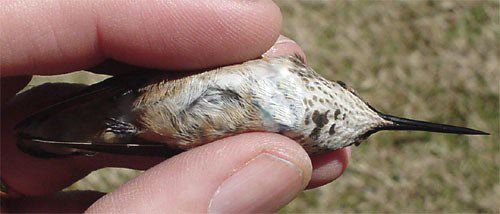 After taking all the usual measurements, we concluded the captive was too large to be an Allen's Hummingbird or a male Rufous Hummingbird, which made female Rufous the proper diagnosis. Careful examination of the bill and plumage--especially the presence of seven orange-red iridescent throat feathers and the shape of the tail feathers--indicated the bird likely was a young bird hatched in 2001.
Age/Sex--Second-year female Weight--3.99g Wing Chord--44.9mm Tail Length--25mm Tail Fork--4.5mm Culmen (upper bill)--18mm Gorget--7 orange-red metallic feathers All text & photos © Hilton Pond Center
If you're interested in sharing your hummingbird observations and learning from other enthusiasts, you may wish to subscribe to Hummingbird Hobnob, our Yahoo!-based discussion group. Also be sure to visit our award-winning Web site for Operation RubyThroat: The Hummingbird Project; on it you'll find almost anything you want to know about hummingbirds, including more information about Hummingbird Banding.
For much more information about hummingbirds, visit Operation RubyThroat: The Hummingbird Project 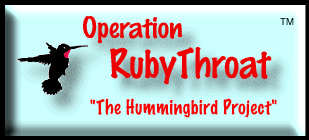 |
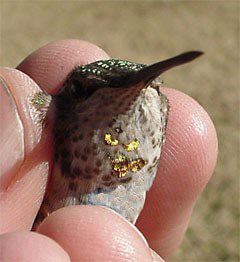 We know Faye and the Russetts well, having spent lots of time with them at meetings and outings of our local Henry's Knob Group of the Sierra Club, so we dropped everything and headed east with our banding tools and portable hummingbird trap.
We know Faye and the Russetts well, having spent lots of time with them at meetings and outings of our local Henry's Knob Group of the Sierra Club, so we dropped everything and headed east with our banding tools and portable hummingbird trap.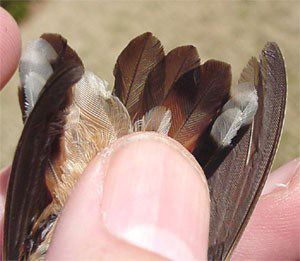 Following Carolyn's release of the bird, we consulted a Rock Hill map to find the exact location of the Russett's house. Curiously, we discovered it was only about a half mile through the woods and across a creek from one of the houses where last week we had tried unsuccessfully for three hours to see and trap a reported Rufous. While still at the Russetts, we called the owner of that house and learned her hummer hadn't been observed for the past several days, heightening our suspicions that we might be dealing with just one bird. Perhaps the Russett's current hummer had gotten some mid-winter wanderlust and decided to desert its original feeding station.
Following Carolyn's release of the bird, we consulted a Rock Hill map to find the exact location of the Russett's house. Curiously, we discovered it was only about a half mile through the woods and across a creek from one of the houses where last week we had tried unsuccessfully for three hours to see and trap a reported Rufous. While still at the Russetts, we called the owner of that house and learned her hummer hadn't been observed for the past several days, heightening our suspicions that we might be dealing with just one bird. Perhaps the Russett's current hummer had gotten some mid-winter wanderlust and decided to desert its original feeding station.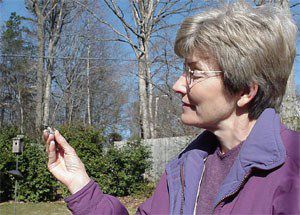 Thanks to Faye Metzl for the vagrant hummer alert and to the Russetts for allowing us to visit and band their bird. And thanks also to Margaret Giles and Doris Williams for entertaining us last week while we waited unsuccessfully for what may well be a neighborhood Rufous Hummingbird they're sharing with the Russetts. The Russett's bird was the tenth winter hummer we've banded within York County in the past three winters, lending more support for the belief that Hilton Pond Center and the county are some sort of vagrant hummingbird hotbed for the Carolina Piedmont.
Thanks to Faye Metzl for the vagrant hummer alert and to the Russetts for allowing us to visit and band their bird. And thanks also to Margaret Giles and Doris Williams for entertaining us last week while we waited unsuccessfully for what may well be a neighborhood Rufous Hummingbird they're sharing with the Russetts. The Russett's bird was the tenth winter hummer we've banded within York County in the past three winters, lending more support for the belief that Hilton Pond Center and the county are some sort of vagrant hummingbird hotbed for the Carolina Piedmont.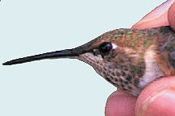
 Students at GLOBE-certified schools may submit winter hummingbird observations as part of Operation RubyThroat and GLOBE. Students can also correlate hummingbird observations with data on abiotic factors, including atmosphere, climate, hydrology, soils, land cover, and phenology. See the
Students at GLOBE-certified schools may submit winter hummingbird observations as part of Operation RubyThroat and GLOBE. Students can also correlate hummingbird observations with data on abiotic factors, including atmosphere, climate, hydrology, soils, land cover, and phenology. See the 


